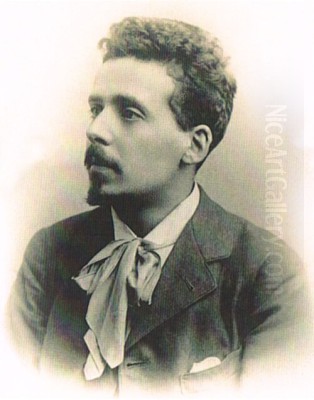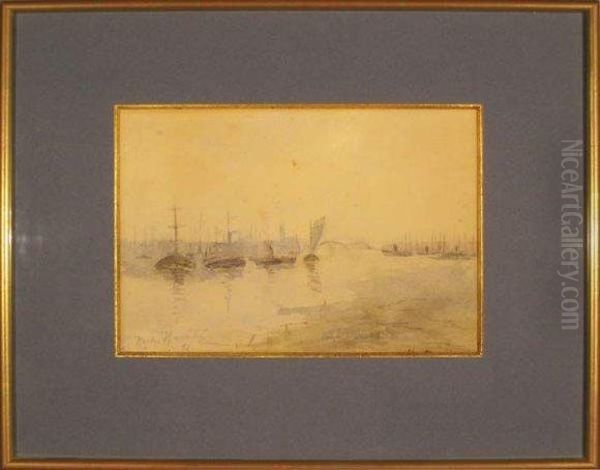
Richard Heintz stands as a significant figure in Belgian art history, an Impressionist painter whose canvases captured the fleeting light and rugged beauty of the Ardennes region with sensitivity and vigour. Born in 1871 and passing away in 1929, Heintz dedicated his career to landscape painting, achieving international recognition for his evocative depictions of nature. His work forms a vital part of the rich tapestry of Belgian Impressionism, reflecting both the influence of its French counterpart and a distinctly local sensibility, particularly rooted in the landscapes around the River Ourthe.
Early Life and Artistic Formation
Richard Heintz entered the world in Herstal, near Liège, Belgium, in 1871. His formative years were spent in the industrial city of Liège, a place that, despite its urban character, was close to the dramatic natural scenery that would become his lifelong inspiration. It was during these early years that Heintz formed a crucial and enduring friendship with Louis Dewis (born Louis Dewachter, 1872-1946). Dewis, who would also become an internationally renowned landscape painter associated with Post-Impressionism, shared these formative experiences with Heintz.
Their childhood bond, forged in Liège, likely played a role in nurturing their mutual artistic inclinations. Growing up during a period when Impressionism was revolutionizing the art world, first in France and then radiating outwards, Heintz and Dewis were exposed to new ways of seeing and representing the world. While specific details about Heintz's formal training or specific mentors are scarce in available records, his development clearly aligned with the Impressionist ethos that emphasized direct observation, capturing momentary effects of light and atmosphere, and a freer application of paint. His connection with Dewis suggests a shared journey of artistic discovery, even if their styles eventually diverged slightly.
The Impressionist Vision of Richard Heintz

Heintz is firmly identified as a Belgian Impressionist painter. His work embodies the core tenets of the movement, adapted to his personal vision and the specific character of the Belgian landscape. He possessed a remarkable ability to capture the transient qualities of light as it played across the hills, forests, and rivers of the Ardennes. His brushwork, often described as quick and free, allowed him to convey the immediacy of his sensory experience directly onto the canvas.
A key characteristic of his style is his use of color. Heintz employed a palette that could be both vibrant and nuanced, adeptly rendering the bright clarity of a sunny afternoon or the muted tones of an overcast day. Scientific analysis of pigments used in his paintings confirms his connection to Impressionist practices. Studies have identified the use of iron oxides, chromium-based pigments, zinc-cadmium yellows, and barium sulfates – materials commonly found on the palettes of Impressionist artists who sought brighter, more varied hues to capture the effects of natural light. This technical aspect underscores his alignment with the movement's innovative approach to color theory and application.
Furthermore, Heintz was sometimes grouped with other Walloon painters under the description "empirisme généreux" (generous empiricism or generous Impressionism). This term suggests an approach rooted in direct observation ("empiricism") but perhaps executed with a certain expressive freedom or richness ("generous"), distinguishing it subtly from the more analytical strands of French Impressionism. His focus remained steadfastly on the landscape, exploring its textures, moods, and the ever-changing interplay of light and shadow.
Capturing the Soul of the Ardennes: Subjects and Key Works
The heart of Richard Heintz's oeuvre lies in his depictions of the Belgian Ardennes, particularly the valley of the River Ourthe and the area around Sy. This region, known for its rolling hills, dense forests, rocky outcrops, and winding river, provided him with endless inspiration. He returned to these motifs repeatedly, exploring them under different weather conditions and at various times of the year, demonstrating a deep connection to this specific environment.
Several works stand out as representative of his artistic focus and style. Paysage de Sy - Le vallon aux corneilles (Landscape of Sy - The Valley of Crows), painted in 1894, is an early yet significant example. Measuring 70 x 100 cm, this oil painting captures a specific view near Sy, a location Heintz frequently painted. Its inclusion in a 2024 exhibition at the Sy Abbey highlights its enduring importance. The work likely showcases his developing Impressionist technique in rendering the rugged terrain and atmospheric conditions of the Ourthe valley. It is held in the collection of the Ecole liégeois du paysage srl, emphasizing its connection to the Liège school of landscape painting.
Another documented work is Vallone du Redu, dated 1920. This painting (40 x 60 cm) suggests his continued engagement with the Ardennes landscape later in his career. The title points to another specific location within the region, indicating his practice of exploring and documenting particular sites. Les grandes cascades à Hockai, an oil painting measuring 40 x 50 cm, focuses on the dramatic natural feature of waterfalls, likely rendered with the dynamic brushwork characteristic of his style, capturing the movement and energy of the water.
Auction records also mention titles like June Afternoon in Sy and Marine. The former reinforces his connection to Sy, evoking a specific time and atmosphere, likely bathed in the warm light typical of his Impressionist approach. The latter, Marine, suggests that while the Ardennes were his primary focus, he may have occasionally turned his attention to coastal scenes, perhaps during travels, broadening his landscape repertoire. These titles, though sometimes lacking detailed descriptions or images in readily available sources, collectively paint a picture of an artist deeply immersed in the observation and interpretation of nature, primarily within his beloved Ardennes.
Contemporaries and Context: Heintz in Belgian Art
Richard Heintz worked during a vibrant period in Belgian art. While Impressionism had originated in France with artists like Claude Monet, Camille Pissarro, and Alfred Sisley, it found fertile ground in Belgium, evolving into distinct local variations, often termed Luminism due to a particular emphasis on light. Heintz was part of this broader movement.
His closest artistic connection was undoubtedly Louis Dewis. Their lifelong friendship, starting in childhood, provides a fascinating parallel narrative of two landscape painters emerging from the same environment. While Dewis leaned more towards Post-Impressionism, their shared roots and dedication to landscape suggest mutual awareness and perhaps subtle influence, even if direct collaboration isn't documented. Their relationship appears to have been one of camaraderie rather than rivalry.
Beyond Dewis, Heintz was contemporary with several key figures of Belgian Impressionism and related movements. Emile Claus is perhaps the most famous Belgian Luminist, known for his sun-drenched depictions of life along the River Leie. Théo van Rysselberghe, initially associated with Neo-Impressionism (Pointillism), also created stunning Impressionist landscapes and portraits. Anna Boch, a painter and collector (and the only female member of the avant-garde group Les XX), contributed significantly with her Impressionist works.
Other important contemporaries include Guillaume Vogels, whose atmospheric, often melancholic landscapes prefigured aspects of Expressionism, and James Ensor, a highly individualistic artist associated with Symbolism and Expressionism but whose early work included Impressionist seascapes. Adrien-Joseph Heymans was another influential landscape painter associated with the Kalmthoutse School, focusing on the Campine region. Georges Lemmen, also linked to Les XX, explored Pointillism before returning to a more intimate Impressionist style. Even the later Symbolist and Expressionist Léon Spilliaert shared the same artistic era, though his haunting Ostend scenes offer a stark contrast to Heintz's generally brighter Ardennes views.
Within the Liège region itself, Heintz was part of a local artistic milieu. Artists like Auguste Donnay and Armand Rassenfosse were active in Liège, though their styles often differed, leaning towards Symbolism or graphic arts. Heintz's dedication to the nearby Ardennes landscape, however, places him centrally within the tradition of the "Ecole liégeoise du paysage" (Liège School of Landscape Painting), even if this term is used more broadly to denote artists focused on the region rather than a formal school with a unified doctrine. Heintz navigated this rich artistic landscape, developing his own voice while clearly participating in the broader Impressionist current that swept through Belgium at the turn of the century.
Exhibitions, Recognition, and Market Presence
Richard Heintz achieved international recognition as a landscape painter during his lifetime. While comprehensive exhibition records might be scattered, his reputation extended beyond Belgium's borders. The fact that his work continues to be exhibited posthumously, such as the 2024 show at the Sy Abbey in Ouffet, France, attests to a sustained interest in his art. This particular exhibition, featuring over thirty works including the significant 1894 Paysage de Sy, demonstrates his specific connection to that region being celebrated even today, and significantly, across the border in France.
His paintings also appear on the art market, indicating ongoing collector interest. Auction results provide glimpses into the valuation of his work. Records show a painting titled June Afternoon in Sy fetching €3,000 at a Rops auction, while another work, Marine, sold for €1,000 at the same venue. Another instance mentions an oil painting by Heintz being offered at GoldField Auctions in September 2023, although the specific outcome isn't detailed in the available summary.
These fragments suggest a consistent, if not always stratospheric, market presence for Heintz's work. The prices reflect appreciation for his skill and his position within Belgian Impressionism. While not reaching the levels of the most famous French Impressionists or top-tier Belgian figures like Ensor or Claus, his work commands respect and finds buyers who value his authentic depictions of the Ardennes. The market activity confirms his status as a recognized and collectible artist.
Legacy and Enduring Appeal
Richard Heintz's legacy lies primarily in his contribution to Belgian Impressionism and his evocative portrayal of the Ardennes. He was a dedicated painter of place, capturing the specific light, atmosphere, and topography of the Ourthe valley and surrounding areas with consistency and passion. His work offers a window into this region at the turn of the 20th century, rendered through the lens of Impressionist sensibility.
The academic interest in his work, particularly through technical analyses of his pigments and techniques, helps solidify his place within art history. These studies provide concrete evidence of his methods and material choices, linking him firmly to the Impressionist movement and allowing for a deeper understanding of his artistic practice and its evolution. They reveal an artist engaged with the technical innovations of his time to better achieve his expressive goals.
His friendship with Louis Dewis adds a personal dimension to his story, highlighting the supportive networks and shared journeys that often underpin artistic careers. Together, they represent a significant strand of landscape painting rooted in the Liège region.
Ultimately, the enduring appeal of Richard Heintz's art rests on its visual qualities: the vibrant yet sensitive handling of color, the dynamic brushwork, and the palpable sense of atmosphere. He successfully translated his deep affection for the Ardennes landscape into paintings that continue to resonate with viewers who appreciate skillful Impressionist technique combined with a genuine connection to the natural world. He remains a respected figure, a master of the Belgian landscape whose canvases preserve the fleeting beauty of the Ardennes light.